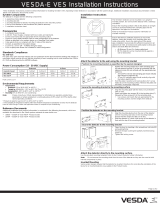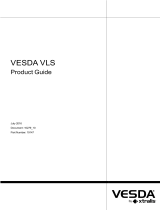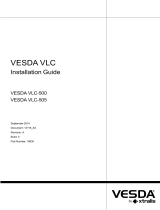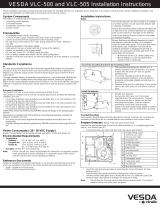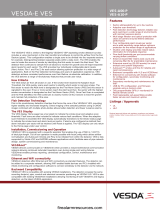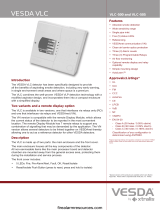Page is loading ...

ICAMby Xtralis ICAMIAS-2 Product Guide
www.xtralis.com i
Intellectual Property and Copyright
This document includes registered and unregistered trademarks. All trademarks displayed are the trademarks of
their respective owners. Your use of this document does not constitute or create a licence or any other right to use
the name and/or trademark and/or label.
This document is subject to copyright owned by Xtralis AG (“Xtralis”). You agree not to copy, communicate to the
public, adapt, distribute, transfer, sell, modify or publish any contents of this document without the express prior
written consent of Xtralis.
Disclaimer
The contents of this document is provided on an “as is” basis. No representation or warranty (either express or
implied) is made as to the completeness, accuracy or reliability of the contents of this document. The manufacturer
reserves the right to change designs or specifications without obligation and without further notice. Except as
otherwise provided, all warranties, express or implied, including without limitation any implied warranties of
merchantability and fitness for a particular purpose are expressly excluded.
General Warning
This product must only be installed, configured and used strictly in accordance with the General Terms and
Conditions, User Manual and product documents available from Xtralis. All proper health and safety precautions
must be taken during the installation, commissioning and maintenance of the product. The system should not be
connected to a power source until all the components have been installed. Proper safety precautions must be taken
during tests and maintenance of the products when these are still connected to the power source. Failure to do so
or tampering with the electronics inside the products can result in an electric shock causing injury or death and may
cause equipment damage. Xtralis is not responsible and cannot be held accountable for any liability that may arise
due to improper use of the equipment and/or failure to take proper precautions. Only persons trained through an
Xtralis accredited training course can install, test and maintain the system.
Liability
You agree to install, configure and use the products strictly in accordance with the User Manual and product
documents available from Xtralis.
Xtralis is not liable to you or any other person for incidental, indirect, or consequential loss, expense or damages of
any kind including without limitation, loss of business, loss of profits or loss of data arising out of your use of the
products. Without limiting this general disclaimer the following specific warnings and disclaimers also apply:
Fitness for Purpose
You agree that you have been provided with a reasonable opportunity to appraise the products and have made
your own independent assessment of the fitness or suitability of the products for your purpose. You acknowledge
that you have not relied on any oral or written information, representation or advice given by or on behalf of Xtralis
or its representatives.
Total Liability
To the fullest extent permitted by law that any limitation or exclusion cannot apply, the total liability of Xtralis in
relation to the products is limited to:
i. in the case of services, the cost of having the services supplied again; or
ii. in the case of goods, the lowest cost of replacing the goods, acquiring equivalent goods or having the goods
repaired.
Indemnification
You agree to fully indemnify and hold Xtralis harmless for any claim, cost, demand or damage (including legal costs
on a full indemnity basis) incurred or which may be incurred arising from your use of the products.
Miscellaneous
If any provision outlined above is found to be invalid or unenforceable by a court of law, such invalidity or
unenforceability will not affect the remainder which will continue in full force and effect. All rights not expressly
granted are reserved.

ICAMIAS-2 Product Guide ICAMby Xtralis
ii www.xtralis.com
Document Conventions
The following typographic conventions are used in this document:
Convention Description
Bold Used to denote: emphasis.
Used for names of menus, menu options, toolbar buttons
Italics Used to denote: references to other parts of this document or other
documents. Used for the result of an action.
The following icons are used in this document:
Convention Description
Caution: This icon is used to indicate that there is a danger to
equipment. The danger could be loss of data, physical damage, or
permanent corruption of configuration details.
Warning: This icon is used to indicate that there is a danger of electric
shock. This may lead to death or permanent injury.
Warning: This icon is used to indicate that there is a danger of inhaling
dangerous substances. This may lead to death or permanent injury.
Contact Us
Europe, Middle East & Africa +44 1442 242 330
D-A-CH +49 431 23284 1
The Americas +1 781 740 2223
Asia +86 21 5240 0077
Australia and New Zealand +61 3 9936 7000
www.xtralis.com
Product Listings
lEN 54-20 (VdS) (Sensitivity Class dependant upon point detector used)
lCE Mark
Regional approvals listings and regulatory compliance vary between ICAM product models. Refer to
www.xtralis.com for the latest product approvals matrix.
Document: 16276_03
Part Number: 09-0112-10

ICAMby Xtralis ICAMIAS-2 Product Guide
www.xtralis.com 1
Table of Contents
1 Introduction 3
2 Detector Installation 5
2.1 Mounting the Detector Enclosure 6
2.2 Wiring 8
2.3 Point Detectors 10
3 Pipe Network Installation 17
3.1 Pipe Specification 17
3.2 Fixings 17
3.3 Sampling Holes 17
3.4 End Cap 18
3.5 Bends 18
3.6 Capillary Tubes 18
3.7 Exhaust 18
3.8 Filters 19
3.9 Open Area Applications 20
4 Configuration 21
4.1 Display Functions 21
4.2 User Interface 22
4.3 Parameters 23
5 Testing 25
5.1 Point Detectors 25
5.2 System 25
6 Maintenance 27
6.1 Air Inlet Filter Replacement Procedure 27
7 Troubleshooting 29
8 Specifications 31
8.1 Typical Supply Current & Fan Speed 31

ICAMby Xtralis ICAMIAS-2 Product Guide
www.xtralis.com 3
1 Introduction
The ICAMIAS-2 system is an aspirating smoke detection system that utilizes an air-sampling pipe network to
draw air towards conventional or analog addressable point detectors in a sealed enclosure.
The dual channel IAS-2 has provision for two separate point detectors, each monitoring a separate sampling
pipe run.
Figure 1-1: ICAMIAS-2 Detector Enclosure
Point detectors are wired directly into the signaling circuit connected to the monitoring fire alarm control panel.
Any alarms or faults derived from the analog or conventional point detector will be reported directly to
monitoring fire panel through the signaling circuit for that detector.
The IAS-2 system provides a configurable aspiration system and airflow monitoring. Airflow status is
displayed on a ten element bar graph with adjustments for flow sensitivity and high/low flow thresholds. Flow
faults are indicated on the display interface LEDs and reported to the central panel via isolated volt-free
contacts.
Important Note: Aspirating Smoke Detectors supplied and installed within the EU from June 2013 must
conform to the EU Construction Products Regulation (305/2011/EU-CPR) and the related European
Standard EN 54-20.
This unit has been tested and certified to ensure general conformance to the above directive and
standard but strict adherence to this Product Guide is required to ensure that the installation meets
these requirements in all respects.
An Approvals overlabel must be completed by the installer and applied to the unit at the time of fitting
the point detectors. The label contains the approved CPR CE mark and sensitivity of the detectors
being fitted and MUST be configured in conformance with this document for the installation to be in full
conformance.
Full details of the labeling requirements together with a table of approved detectors and required
sensitivity information are found in Chapter 2.

ICAMby Xtralis ICAMIAS-2 Product Guide
www.xtralis.com 5
2 Detector Installation
The ICAMIAS-2 is provided with the following components:
l1 detector enclosure
l1 corner stud key
l1 blanking baffle
l1 ferrite core
l1 mounting template
l1 product guide
lApprovals overlabels
Check all components for damage and refer any concerns to your authorized representative.
It is necessary to procure the following additional items:
lPoint detectors. Refer to Section 2.3.2 on page 10 for further information.
lBaffle for the selected point detector. Refer to Section 2.3.1 on page 10 for further information.
lScrews and inserts for fixing the unit in place at the installation location.
B
C
E
A
D
Legend
APoint Detector 1
BPoint Detector 2
CIntake from Pipe Network 1
DIntake from Pipe Network 2
EAirflow
FExhaust
Figure 2-1: Detector Enclosure

ICAMIAS-2 Product Guide ICAMby Xtralis
6www.xtralis.com
2.1 Mounting the Detector Enclosure
Notes:
lThis equipment must be installed by a qualified installer in accordance with all local and national code
requirements.
lThe detector assembly must be installed at an accessible position to facilitate maintenance and testing.
lEnsure that there is sufficient clearance to mount the detector, noting the location of air sampling pipes
and cable entry points. Owing to the rigid nature of the plastic pipe, installation must provide for sufficient
movement in all pipe work (air inlet, air exhaust and cable pipes) to allow pipe ends to be easily fitted and
removed.
lEnsure that the exhaust pipe is free from any obstacles at all times.
lDo not mount the detector assembly close to a heat source.
lMount the detector assembly in a secure location which is accessible only by authorised personnel.
Mounting Procedure:
1. Remove the transparent cover (D) by using the corner stud key (B)to unscrew the tamper-proof corner
studs (A).
2. Tape the mounting template to the mounting surface and use it to accurately mark the holes
corresponding to the four corner fixing points.
3. Drill four holes in the mounting surface.
4. Remove the mounting template.
5. Secure the detector enclosure to the mounting surface through the four corner fixing points. Use
appropriate fasteners for the type of surface that the unit is mounted on. The diameter of each mounting
hole is 5mm. Typical No. 8 mounting hardware can be used in the mounting holes.
B
A
C
D
Legend
ACorner Stud
BCorner Stud Key
CScrew holes
DTransparent Cover
Figure 2-2: Detector Enclosure

ICAMIAS-2 Product Guide ICAMby Xtralis
8www.xtralis.com
2.2 Wiring
The following wiring connections must be made to the detector housing:
l24V DC Power Supply. Refer to Section 2.2.3 for further information.
lLoop or circuit wiring. Refer to Section 2.2.4 for further information.
lFault Relay. Refer to Section 2.2.5 for further information.
The wiring enters the detector housing via cable seals and is connected to the appropriate terminals on the
main circuit board or display board. The terminals allow wire with a maximum diameter of 2.5mm².
Warning: To prevent risk of electric shock or possible injury from the rotation of the high performance fan,
the system should be isolated from the power supply when the display board is removed.
Caution: When installing or servicing the unit, ensure that the operator is safely grounded so as to prevent
electro-static discharge (ESD) damage to the unit.
2.2.1 Wiring Access
For correct operation of the unit it is essential that the case is fully sealed so that air can only be drawn into the
system through the aspirating pipe. Thus, all wiring must pass through the cable seals provided and no
additional holes should be made in the detector housing.
To pass wiring through a cable seal, make a small hole in the centre of the seal with a pointed implement (e.g.
small screwdriver) and then force the cable through the hole into the box. The small hole should expand to
accommodate any cable diameter from 4 to 10 mm. If the seal is not airtight, then it may be necessary to use
a non-reactive resin or glue to create an airtight seal to ensure that air is only drawn through the air sampling
pipe network.
2.2.2 Connect Wiring
To gain access to the terminals on the main circuit board for connection of the wiring, remove the
display/detector mounting board which is held in place by the clear top cover. To fully remove the
display/detector mounting board, disconnect the ribbon cable from the rear of the board.
Caution: Care should be taken when removing the board to ensure that the ribbon cable on the underside
is not strained.
1. 24 VDC input power supply
2. Input power fuse
3. Loop / circuit wiring interface
4. Fault 1 relay terminal
5. Fault 2 relay terminal
Figure 2-4: Field connectors for the IAS-2 detector

ICAMby Xtralis ICAMIAS-2 Product Guide
www.xtralis.com 9
2.2.3 24V DC Input
The IAS-2 unit is designed to run from a 24 VDC supply. The supply should be connected to the two-way
BATTERY connector on the main circuit board ensuring that the wires are correctly orientated. The minimum
recommended wire size is 16x0.25mm(18AWG), or larger if the supply is further than 5m from the system.
A ferrite core is provided for EMC compliance. This should be fitted to the supply wiring inside the enclosure
as shown in Figure 2-5.
Figure 2-5: Ferrite core and battery supply wiring
The power requirements are dependant on the fan speed. Refer to Section 8.1 for further information.
2.2.4 Circuit Connection
The loop or circuit wiring can be connected to the point detector(s) with either of two methods:
lthe wiring can be connected to the LOOP IN and LOOP OUT terminals on the main circuit board (refer to
Section 2.2.2). Additionally, the terminals on the point detector(s) must be connected to the detector
terminals located in the center of the point detector mounts on the underside of the mounting board. This
is the preferred method.
lthe wiring can be connected directly to terminals on the point detector(s). It should be routed via the
cutouts in the mounting board.
The LOOPIN and LOOPOUT terminals are connected to the detector terminals on the display board via the
ribbon cable. This provides a convenient means of connecting the loop/circuit wiring to the unit and allows the
display and detectors to be removed during servicing by simply disconnecting the ribbon cable.
2.2.5 Fault Relays
In the event of a fault condition, the FAULT1 and/or FAULT2 relay will change state. The terminals provide for
Normally Open (NO) or Normally Closed (NC) operation and can be wired to terminating resistors to simulate
a zone fault on a conventional control panel or a loop interface module for an analog addressable panel.
Loop interface modules should be mounted outside of the enclosure unless tested and approved for use within
the IAS-2 system. Refer to Section 2.3.3 for the list of approved interface modules.
Notes:
lNO/NC refers to the un-powered state of the relays. Under normal operation (non-fault conditions), NO is
closed and NC is open.
lPlease note that the faults for Channel 1 will actuate the FAULT1 relay and faults for Channel 2 will
actuate the FAULT2 relay.

ICAMIAS-2 Product Guide ICAMby Xtralis
10 www.xtralis.com
2.3 Point Detectors
If the installation is to be done in accordance with EN 54-20 requirements, then the detector must have been
tested and approved for use in the system. Section 2.3.2 below contains the list of supported point detectors.
2.3.1 Baffles
Baffles are used to direct the sampled air flow through the point detectors. They are shaped to match a
particular model or range of detectors and simply clip into position in the slots provided in the transparent lid of
the detector housing.
Caution: To ensure correct performance the baffles MUST be fitted. Care should be taken when removing
and re-fitting the transparent lid to ensure that the baffles remain in the slots and do not get lost.
Please contact your local ICAM distributor for ordering information.
2.3.2 Point Detector Selection
The following point detectors have been listed for use in the IAS-2 unit and are suitable for installations
requiring EN 54-20 listing. The table shows the limits that should not be exceeded if the installation is to
conform to requirements.
Ensure that the selected point detectors have sufficient sensitivity for the application. Refer to Chapter 3 for
information on how dilution affects detector sensitivity.
The following detectors have been independently tested and certified for use in the IAS-2 unit and are suitable
for EN 54-20 approved Class C installations, or Class A, B or C installations. The following sections will show
the requirements for compliance in each category.

Class C Detectors
The detectors in Table 2-1 are suitable for Class C installations only. The Class C over-label provided with the IAS-2 device should be applied as shown in Figure 2-6 with the
maximum number of holes written in the white box provided.
The table shows the limits that should not be exceeded if the installation is to conform to Class C requirements. All figures are based on the standard configurations shown in
Section 3.9 with a fan speed of 9 unless otherwise stated.
Detector Brand Detector
Model
Sampling Hole Limits per
Pipe
Maximum Pipe
Length (m) per
Pipe
Maximum #
Holes per Pipe
Panel / Detector Configuration Baffle Order
Code
Baffle Notes
APOLLO S65 Optical 1 x 8 mm End Hole 50 1 Standard Sensitivity 06-AP10 Standard Base
XP95 Optical 1 x 8 mm End Hole 50 1 Pre-alarm = 45 06-AP10 Standard Base
DISCOVERY
Optical
1 x 8 mm End Hole 50 1 Alarm = 55 06-AP10 Standard Base
DISCOVERY
Optical
2 x 5 mm Holes 50 2 Pre-alarm = 45 06-AP10 Standard Base
ARGUS Sagittarius
SG100
1 x 8mm End Hole 50 1 Standard Sensitivity 06-AG10 Standard Base
DETECTOMAT CT 3000 O 1 x 8 mm End Hole 50 1 Standard Sensitivity 06-DT10 Standard Base
PL 3200 O 1 x 8 mm End Hole 50 1 Standard Sensitivity 06-DT10 Standard Base
PL 3300 O 1 x 8 mm End Hole 50 1 Standard Sensitivity 06-DT10 Standard Base
UTCEDWARDS DP 652 1 x 8 mm End Hole 50 1 Standard Sensitivity 06-AP10 Standard Base
DP 721I 3 x 4 mm Holes 50 3 Standard Sensitivity 06-GE20 Standard Base
DP 2061 4 x 4 mm Holes 40 4 High Sensitivity 06-GE20 Standard Base
DP 951 1 x 8 mm End Hole 50 1 Pre-alarm = 45 06-AP10 Standard Base
DP 991 1 x 8 mm End Hole 50 1 Alarm = 55 06-AP10 Standard Base
DP 991 2 x 5 mm Holes 50 2 Pre-alarm = 45 06-AP10 Standard Base
HOCHIKI SLR-E3 1 x 8 mm End Hole 50 1 Standard Sensitivity 06-HK10 Standard Base
ALG-E 1 x 8 mm End Hole 40 1 High Sensitivity 06-HK10 Standard Base
SIEMENS FDOOTC241 1 x 8mm End Hole 50 1 Mode 10 - Balanced CO 06-SM10 FDB222
FDOOTC241 1 x 8mm End Hole 50 1 Mode 6 - Fast Response 06-SM10 FDB222
FDOOTC241 2 x 5mm Holes 50 2 Mode 9 - High Sensitivity Fast 06-SM10 FDB222
Table 2-1: Tested and Certified Class C Detectors
ICAMby Xtralis ICAMIAS-2 Product Guide
www.xtralis.com 11

ICAMIAS-2 Product Guide ICAMby Xtralis
Detector Brand Detector
Model
Sampling Hole Limits per
Pipe
Maximum Pipe
Length (m) per
Pipe
Maximum #
Holes per Pipe
Panel / Detector Configuration Baffle Order
Code
Baffle Notes
SYSTEM
SENSOR
2251EM 1 x 8 mm End Hole 50 1 Standard Sensitivity = 2200 06-SS10 Standard Base
2251EM 2 x 5 mm Holes 50 2 High Sensitivity = 1800 06-SS10 Standard Base
TYCO MX 801PH 2 x 4 mm Holes 50 2 HPO Standard Sensitivity 06-AD10 Standard Base
MX 830PH 2 x 4mm Holes 50 2 HPO Standard Sensitivity, Fast-
Logic = ON
06-AD10 Standard Base
MX 830PH 3 x 4mm Holes 50 3 HPO High Sensitivity, Fast-Logic
= ON
06-AD10 Standard Base
FC 460PH 1 x 8mm End Hole 50 1 HPO High Sensitivity 06-AD10 Standard Base
MX 850PH 2 x 4mm Holes 50 2 HPO Standard Sensitivity, Fast-
Logic = ON
06-AD10 Standard Base
MX 850PH 3 x 4mm Holes 50 3 HPO High Sensitivity, Fast-Logic
= ON
06-AD10 Standard Base
Table 2-1: Tested and Certified Class C Detectors (continued...)
Notes:
1. Siemens FDOOTC241 and Tyco MX 850PH detectors incorporate Short Circuit Isolation approved to EN 54-17.
2. To ensure the correct operation of the Short Circuit Isolation functionality, point detectors or bases with Short Circuit Isolation approved to EN 54-17 should be wired
directly to the loop as shown in Section 2.3.6, Figure 2-10.
3. ARGUS Sagittarius SG100 detectors are battery powered wireless devices approved to EN 54-25. These require no physical wiring.
12 www.xtralis.com

ICAMby Xtralis ICAMIAS-2 Product Guide
www.xtralis.com 13
Class A, B and C Detectors
The following detectors are suitable for Class A, B and C installations:
lSystem Sensor 7251EM (Baffle order code 06-SS10)
lSystem Sensor LZR1-M (Baffle order code 06-SS10)
lNotifier FSL-7251E View (Baffle order code 06-SS10)
The Class A, B, C over-label should be applied as shown in Figure 2-6. The maximum number of holes for
these detectors is printed on the over-label. All figures are based on the standard configurations shown in
Section 3.9 with a fan speed of 9 unless otherwise stated.
Panel Sensitivity Maximum Number of Holes per Class, per Pipe
Class C Class B Class A
1 18 6 3
2 9 3 1
3 4 1 N/A
4 1 N/A N/A
5 or above N/A N/A N/A
Table 2-2: Sensitivity and Maximum Holes per Class
Note: Table 2-2 shows the limits that should not be exceeded for the three sensitivity classes. Figures are
based upon the configurations shown in Section 3.9.
Note: Any changes to the standard configuration or settings shown above should be verified using ICAM
ASPIRE2 pipe modeling software. The latest version of ICAM ASPIRE2 is available from
www.xtralis.com.
2.3.3 Loop Interface Module Selection
Specific I/O modules are approved to be fitted within the IAS-2 detector enclosure. These are:
lTyco - MIM800 Addressable Module
lApollo - 55000-760 Mini Switch Monitor
2.3.4 Point Detector Installation
One or two conventional or analog addressable point detectors are attached to the mounting board using the
provided screws. The point detector wiring passes through the 'D' shaped access holes in the display board
and either connect to the terminals provided on the reverse of the display board or connected directly to the
signalling circuit.
When one point detector is installed, the detector should be placed in the Channel 1 position.
Note: The installer should refer to the point detector manufacturer's technical literature for wiring details
and detector/panel configuration settings.
2.3.5 Overlabel Application
The IAS-2 detector is provided with overlabels containing the EN 54-20/CPR compliance details.
As part of compliance to device listing requirements, the label that corresponds to the point detectors that are
being fitted to the IAS-2 must be affixed to the markings label found on the right side of the unit contained in
this shipping package, as shown below in Figure 2-6. The correct overlabel is selected by reference to Section
2.3.2. In the case of Class C detectors the installer must enter the maximum number of holes permitted for the
detector in the space provided on the overlabel.

ICAMby Xtralis ICAMIAS-2 Product Guide
www.xtralis.com 15
2.3.6 Wiring Examples
The following examples show typical installations for conventional and analog addressable detectors. Please
ensure that all wiring complies with manufacturer's instructions and local and national fire detection code
requirements.
Configuration with Conventional Detectors
The terminating resistor is wired across both fault relays so a flow fault in either channel will produce a zone
fault.
Legend
1 Display/Detector Mounting Board
2 Main Circuit Board
3 Ribbon Connector
5 Point Detector 1
6 Point Detector 2
7 Terminating Resistor
9 Addressable Loop/Conventional
Circuit
Figure 2-7: Wiring diagram for an IAS-2 system with two conventional detectors
Configuration with Conventional Detectors connected in series
The schematic shows the first and last units in a chain of IAS-2 units. Zone circuit wiring is returned from last
unit to first via fault relay contacts in each unit and a terminating resistor fitted to first unit as shown. A flow
fault condition in any unit will break the connection to the terminating resistor and indicate a zone fault without
affecting the operation of the detectors themselves.
Legend
1 Display/Detector Mounting Board
2 Main Circuit Board
3 Ribbon Connector
5 Point Detector 1
6 Point Detector 2
7 Terminating Resistor
9 Addressable Loop/Conventional
Circuit
Figure 2-8: Wiring diagram showing IAS-2 systems connected in series

ICAMIAS-2 Product Guide ICAMby Xtralis
16 www.xtralis.com
Configuration with Analog Addressable Detectors
The diagram shows the fault relays connected to the signalling circuit via interface modules.
Legend
1 Display/Detector Mounting Board
2 Main Circuit Board
3 Ribbon Connector
5 Point Detector 1
6 Point Detector 2
8 Loop Interface Module
9 Addressable Loop/Conventional
Circuit
Figure 2-9: Wiring diagram showing analog addressable detector connections
Configuration with directly wired Addressable Detectors
The following schematic shows detectors wired directly to the loop with the FAULT relays connected to loop
via addressable modules.
Note: Depending upon the make and model of detector being used, the Loop IN/Loop OUT wiring
connections may be different to that shown below. Please refer to the detector manufacturers
installation instructions for the correct wiring scheme to be used.
Legend
1 Display/Detector Mounting Board
2 Main Circuit Board
3 Ribbon Connector
5 Point Detector 1
6 Point Detector 2
8 Loop Interface Module
9 Addressable Loop/Conventional
Circuit
Figure 2-10: Wiring diagram showing directly wired Addressable Detectors
/







